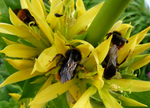
ERLER Silvio
Recommendations: 0
Review: 1
Review: 1

Cuckoo male bumblebees perform slower and longer flower visits than free-living male and worker bumblebees
Cuckoo bumblebee males might reduce plant fitness
Recommended by Michael Lattorff based on reviews by Patrick Lhomme, Silvio Erler and 2 anonymous reviewersIn pollinator insects, especially bees, foraging is almost exclusively performed by females due to the close linkage with brood care. They collect pollen as a protein- and lipid-rich food to feed developing larvae in solitary and social species. Bees take carbohydrate-rich nectar in small quantities to fuel their flight and carry the pollen load. To optimise the foraging flight, they tend to be flower constant, reducing the flower handling time and time among individual inflorescences (Goulson, 1999). Males of pollinator species might be found on flowers as well. As they do not collect any pollen for brood care, their foraging flights and visits to flowers might not be shaped by the selective forces that optimise the foraging flights of females. They might stay longer in individual flowers, take up nectar if needed, but might unintentionally carry pollen on their body surface (Wolf & Moritz, 2014).
Bumblebees are excellent pollinators (Goulson, 2010), and a few species are exploited commercially for their delivery of pollination services (Velthuis & van Doorn, 2006). However, a monophyletic group of socially parasitic species – cuckoo bumblebees – has evolved amongst the bumblebees, lacking a worker caste. Cuckoo bee gynes usurp nests of free-living bumblebees, kill the resident queen, and forces the host workers to rear their offspring consisting of gynes and males (Lhomme & Hines, 2019). The level of affected colonies in an area can be up to 42% (Erler & Lattorff, 2010).
The behaviour of the cuckoo bumblebees, especially that of the males, has been rarely studied. The present study by Fisogni et al. (2021) has targeted the flower-visiting behaviour of workers and males of free-living bumblebees and males of the cuckoo species. They used behavioural observations of flower-visiting insects on Gentiana lutea, a plant from south-eastern Europe with yellow flowers arranged in whorls. While all three groups of bees visited the same number of plants, males of both types visited more flowers within a whorl, but cuckoo males spent more time on flowers within a whorl and the whole plant than the free-living bumblebees.
The flower visits of bumblebee workers are optimised, aiming at collecting as much pollen as possible within a short time frame. This, in turn, has consequences for the pollination process by enhancing cross-pollination between different plants. By contrast, males and especially cuckoo bumblebee males, are not selected for an optimised foraging pattern. Instead, they spend more time on flowers, eventually resulting in higher levels of pollen transfer within a plant (geitonogamy), which might lead to reduced plant fitness. This is the first study to relate the foraging behaviour of cuckoo bumblebees to pollination and plant fitness.
References
Erler, S., & Lattorff, H. M. G. (2010). The degree of parasitism of the bumblebee (Bombus terrestris) by cuckoo bumblebees (Bombus (Psithyrus) vestalis). Insectes sociaux, 57(4), 371-377. https://doi.org/10.1007/s00040-010-0093-2
Fisogni, A., Bogo, G., Massol, F., Bortolotti, L., Galloni, M. (2021). Cuckoo male bumblebees perform slower and longer flower visits than free-living male and worker bumblebees. Zenodo, 10.5281/zenodo.4489066, ver. 1.2 peer-reviewed and recommended by PCI Zoology. https://doi.org/10.5281/zenodo.4489066
Goulson, D. (1999). Foraging strategies of insects for gathering nectar and pollen, and implications for plant ecology and evolution. Perspectives in plant ecology, evolution and systematics, 2(2), 185-209. https://doi.org/10.1078/1433-8319-00070
Goulson, D. (2010). Bumblebees. Behaviour, Ecology, and Conservation, 2nd edn. Oxford University Press, Oxford.
Lhomme, P., Hines, H. M. (2019). Ecology and evolution of cuckoo bumble bees. Annals of the Entomological Society of America, 112, 122-140. https://doi.org/10.1093/aesa/say031
Velthuis, H. H. W., van Doorn, A. (2006). A century of advances in bumblebee domestication and the economic and environmental aspects of its commercialization for pollination. Apidologie, 37, 421-451. https://doi.org/10.1051/apido:2006019
Wolf, S., Moritz, R. F. A. (2014). The pollination potential of free-foraging bumblebee (Bombus spp.) males (Hymenoptera. Apidae). Apidologie, 45, 440-450. https://doi.org/10.1007/s13592-013-0259-9